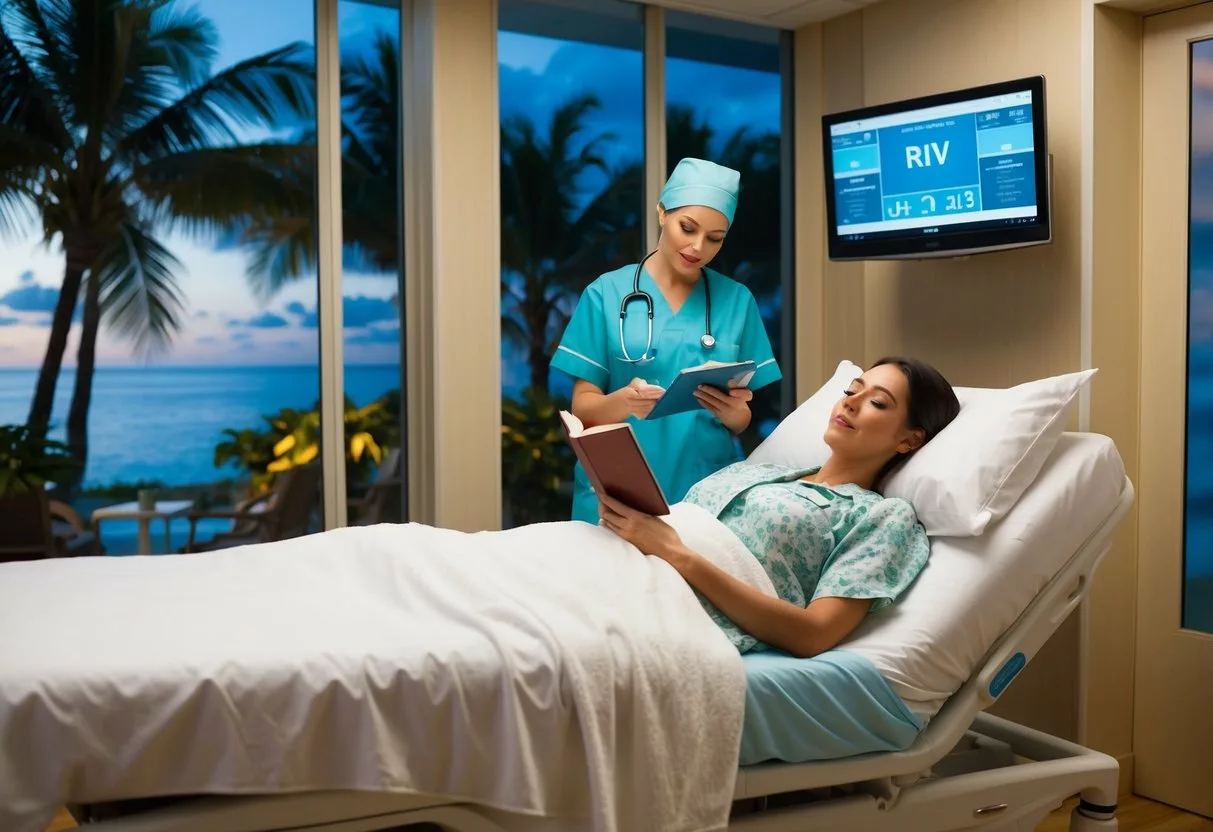Breast augmentation tourism has grown in popularity as more people seek affordable options for cosmetic surgery abroad. Many countries offer high-quality procedures at lower costs than in the United States or United Kingdom. Top destinations for breast augmentation include Brazil, South Korea, Thailand, Mexico, and Spain, each offering unique advantages in expertise and pricing.

Traveling for breast augmentation requires careful planning and research. Patients must consider factors like surgeon qualifications, facility standards, and post-operative care. While overseas options can be cost-effective, they also come with potential risks and challenges that need to be weighed against the benefits.
Proper precautions and risk assessments are essential for a safe medical journey. Patients should thoroughly research their chosen destination, surgeon, and facility. They should also plan for adequate recovery time before traveling home and arrange for follow-up care with a local doctor upon return.
Key Takeaways
- Breast augmentation tourism offers cost-effective options in various countries
- Careful research and planning are crucial for a safe and successful procedure
- Post-operative care and follow-up are important considerations when traveling for surgery
Understanding Breast Augmentation
Breast augmentation is a popular cosmetic surgery that can enhance breast size and shape. It involves placing implants to increase breast volume and improve body proportions.
Breast Augmentation Explained
Breast augmentation surgery adds volume to the breasts using implants. A plastic surgeon makes an incision and creates a pocket in the breast tissue or chest muscle. They insert the implant into this pocket.
The surgery takes 1-2 hours under general anesthesia. Recovery time is about 1-2 weeks for most activities. Full healing can take several months.
Breast augmentation can be done for many reasons. Some women want to increase small breasts. Others aim to restore volume lost after pregnancy or weight loss. The surgery can also improve breast symmetry.
Types of Breast Implants
There are two main types of breast implants: saline and silicone. Saline implants contain sterile salt water. They are inserted empty and filled once in place. This allows for smaller incisions.
Silicone implants are pre-filled with silicone gel. Many women feel they look and feel more natural. Both types come in various sizes and shapes. Round implants add fullness to the upper breast. Teardrop shapes mimic the natural breast slope.
Implant placement can be submuscular (under the chest muscle) or subglandular (over the muscle, under breast tissue). The surgeon will recommend the best option based on body type and goals.
Potential Benefits of Breast Augmentation
Breast augmentation can boost self-esteem and body image for many women. It can create a more balanced figure and improve clothing fit. Some women report feeling more feminine and confident after the procedure.
The surgery can restore breast volume lost due to aging, pregnancy, or weight changes. It can also correct breast asymmetry. For some, it may reduce the need for padded bras or breast enhancers.
Breast augmentation can be combined with a breast lift for more dramatic results. This can address sagging along with size concerns. Modern techniques aim for natural-looking results that complement a woman’s body shape.
Planning Your Medical Tourism Journey

Careful planning is key for a successful breast augmentation abroad. Consider factors like destination, surgeon qualifications, and travel logistics to ensure a smooth experience.
Choosing a Destination
Popular destinations for breast augmentation tourism include South Korea, Brazil, Thailand, Turkey, India, Mexico, Spain, Colombia, and Costa Rica. Each country offers unique benefits:
- Thailand: Known for skilled surgeons and affordable prices
- South Korea: Advanced technology and expertise in cosmetic procedures
- Mexico: Close proximity for North American patients
- Brazil: Home to many experienced plastic surgeons
Consider factors like travel time, cultural differences, and local healthcare standards when selecting a destination. Climate and recovery amenities may also influence your choice.
Researching Skilled Surgeons
Finding a qualified surgeon is crucial for safe and satisfactory results. Steps to take:
- Check credentials and board certifications
- Review before-and-after photos of previous patients
- Read patient testimonials and reviews
- Schedule initial consultations with potential surgeons
Look for surgeons with experience treating international patients. Many reputable clinics offer video consultations to discuss your goals and answer questions before you travel.
Preparation for Travel and Procedure
Once you’ve chosen a destination and surgeon, focus on trip logistics:
- Book flights and accommodations
- Arrange transportation to and from the clinic
- Pack comfortable clothing for recovery
- Bring necessary medical records and test results
Plan to arrive a few days before surgery for pre-operative appointments. Schedule enough time for proper recovery before flying home. Most surgeons recommend staying at least two weeks after the procedure.
Consider bringing a companion for support during recovery. Research local attractions or relaxation options for downtime between appointments.
Ensuring Quality and Safety

Choosing a reputable facility and qualified surgeon is crucial for breast augmentation abroad. Proper accreditation, thorough evaluations, and safety measures help ensure positive outcomes.
Importance of Accreditation
Accreditation shows that a hospital or clinic meets high standards of care. Look for facilities with international accreditation like Joint Commission International (JCI).
Global Healthcare Accreditation (GHA) focuses on medical travel. It reviews patient experience, cultural competence, and quality of care for international patients.
Accredited facilities often have:
• Better safety records
• More qualified staff
• Higher quality equipment
• Stricter hygiene protocols
Patients should verify accreditation claims on official websites before booking.
Evaluating International Hospitals and Clinics
Research is key when picking a facility abroad. Check the hospital’s track record, surgeon qualifications, and patient reviews.
Look for:
• Board-certified plastic surgeons
• Surgeons with extensive breast augmentation experience
• Modern, well-equipped operating rooms
• Clear infection control policies
Ask about:
• Surgeon training and credentials
• Number of breast augmentations performed yearly
• Complication rates
• Before and after photos of past patients
Top destinations like the USA, Brazil, and South Korea often have strict regulations for cosmetic surgery clinics.
Patient Safety Considerations
Safety should be the top priority for breast augmentation abroad. Patients need to take steps to protect their health.
Key safety measures:
• Get a full medical evaluation before travel
• Discuss implant options and potential risks with the surgeon
• Ensure the clinic uses FDA-approved implants
• Plan for adequate recovery time before flying home
Patients should also:
• Arrange follow-up care in their home country
• Get all medical records and surgical notes
• Purchase travel insurance that covers complications
• Learn about local emergency services at their destination
Proper planning helps minimize risks and ensures a smoother recovery after surgery.
The Role of Healthcare Professionals

Healthcare professionals play a crucial part in breast augmentation tourism. Their expertise and support are key to a safe and successful procedure.
Selecting a Qualified Plastic Surgeon
Choosing the right plastic surgeon is vital. Look for a board-certified plastic surgeon with experience in breast augmentation. Check their credentials, training, and past work.
Ask about their specific experience with international patients. A qualified surgeon should be able to show before and after photos of their work.
It’s important to verify the surgeon’s license and certifications. Many countries have professional boards that oversee plastic surgeons.
Consider scheduling a video consultation before traveling. This allows patients to ask questions and assess the surgeon’s communication style.
Communication and Support from Medical Staff
Clear communication is essential for a positive patient experience. The medical staff should be fluent in the patient’s language or provide a translator.
Nurses and other staff members play a big role in pre and post-operative care. They should be knowledgeable and attentive to patient needs.
Good medical teams offer detailed pre-surgery instructions. They also provide comprehensive aftercare guidelines.
Patients should have access to 24/7 support, especially in the days following surgery. This ensures any concerns are addressed promptly.
The medical staff should be prepared to coordinate with the patient’s local doctor for follow-up care after they return home.
Financial Aspects of Breast Augmentation Abroad

Breast augmentation abroad can offer significant cost savings. Patients can find affordable options while still receiving quality care. Understanding the financial aspects is key to making an informed decision.
Comparing Costs Internationally
Breast augmentation costs vary widely across countries. In the United States, the procedure can be expensive, often ranging from $5,000 to $10,000.
Many other countries offer lower prices. For example:
- Thailand: $2,500 – $3,500
- Mexico: $3,000 – $4,500
- Spain: $4,000 – $5,500
These prices often include surgeon fees, anesthesia, and facility costs. Some packages may also cover hotel stays and transportation.
Patients should research thoroughly. Lower costs don’t always mean lower quality. Many international clinics maintain high standards of care.
Understanding Cost-Effectiveness
Cost-effectiveness goes beyond the initial price tag. Patients should consider long-term value and quality of results.
Factors affecting cost-effectiveness include:
- Surgeon expertise
- Clinic accreditation
- Quality of implants used
- Follow-up care
Medical tourism destinations often combine skilled surgeons with state-of-the-art facilities. This can lead to excellent results at lower prices.
Patients should also factor in travel expenses. Even with these added costs, the total may still be less than surgery in the United States.
Handling Unexpected Expenses
Planning for unforeseen costs is crucial when considering breast augmentation abroad. Patients should budget for potential additional expenses.
Common unexpected costs may include:
- Extended hotel stays due to recovery
- Additional medical tests
- Revision surgery if needed
Travel insurance that covers medical procedures is highly recommended. This can protect against large unexpected bills.
Patients should also set aside funds for follow-up care upon returning home. Local doctors may charge for check-ups or addressing complications.
Clear communication with the clinic about all potential costs can help avoid surprises. Many reputable clinics offer transparent pricing and can provide detailed breakdowns.
The Surgical Procedure

Breast augmentation surgery involves precise techniques and protocols to enhance breast size and shape safely. The procedure typically takes 1-2 hours and uses implants or fat transfer methods.
Operative Techniques and Incision Types
Surgeons use different incision types for breast implant placement. Common options include:
- Inframammary: Under the breast fold
- Periareolar: Around the nipple
- Transaxillary: In the armpit
Each type has pros and cons. Inframammary incisions allow good implant access but may leave visible scars. Periareolar incisions blend with the nipple edge but can affect sensation. Transaxillary incisions hide scars but make implant placement trickier.
Implants go either above or below the chest muscle. Submuscular placement looks more natural but has a longer recovery. Over-the-muscle placement is simpler but may show implant edges more.
Anesthesia and Operating Room Protocol
General anesthesia keeps patients asleep and pain-free during surgery. An anesthesiologist monitors vital signs throughout.
The operating room follows strict sterile procedures:
- Staff wear sterile gowns, gloves, and masks
- Surgical tools are sterilized
- The chest area is cleaned with antiseptic
- Sterile drapes cover the patient
These steps lower infection risk. The surgeon marks incision sites before starting. A nurse assists by handing instruments and monitoring the patient.
Ensuring Optimal Results
Surgeons take steps to get the best outcome:
- Careful implant sizing and selection
- Precise pocket creation for implant placement
- Ensuring symmetry between breasts
- Closing incisions in layers for minimal scarring
They may use sizers to check appearance before final implant placement. Some add internal sutures for extra support.
Proper closure techniques help scars fade. Surgeons often apply special tapes or dressings after. They give detailed aftercare instructions to promote healing and good results.
Post-Operative Experience

Breast augmentation tourism requires careful attention to recovery and follow-up care. Patients need to be aware of the healing process and potential complications that may arise after surgery.
Recovery Time and Process
The recovery time for breast augmentation typically lasts several weeks. During the first week, patients may experience pain, swelling, and bruising. Rest is crucial during this period.
By weeks 3-4, many patients feel more comfortable and can resume light activities. Energy levels often increase at this stage.
Full recovery usually takes about 6 weeks. At this point, most women can return to normal activities, including exercise.
It’s important to follow the surgeon’s instructions closely during recovery. This may include wearing a special bra and avoiding certain movements.
Follow-Up Care and Monitoring
Regular follow-up appointments are essential after breast augmentation surgery. These visits allow the surgeon to monitor healing and address any concerns.
Initial check-ups often occur within the first week after surgery. The surgeon will examine the incisions and overall healing progress.
Subsequent appointments may be scheduled at 1 month, 3 months, and 6 months post-surgery. These visits help ensure proper implant settling and tissue healing.
Patients should report any unusual symptoms or concerns to their surgeon promptly. This includes persistent pain, fever, or changes in breast appearance.
Dealing with Complications such as Infection
While rare, infections can occur after breast augmentation. Signs of infection include fever, redness, swelling, and unusual discharge from incision sites.
If infection is suspected, immediate medical attention is crucial. Treatment may involve antibiotics or, in severe cases, implant removal.
Other potential complications include implant displacement, capsular contracture, or changes in nipple sensation. Regular monitoring helps detect these issues early.
Revision surgery may be necessary to address certain complications. This emphasizes the importance of choosing a skilled surgeon and following all post-operative instructions carefully.
Long-Term Considerations

Breast augmentation tourism has lasting impacts on a person’s health, appearance, and well-being. Patients need to think about ongoing care, satisfaction over time, and future effects of the procedure.
Maintaining Breast Health
Regular check-ups are crucial after breast augmentation. Patients should schedule yearly mammograms and breast exams. These screenings help detect any issues early.
Implants can make it harder to spot breast cancer. Special mammogram techniques may be needed. Patients should inform their doctors about their implants.
Self-exams are important too. Women should learn how to check their breasts with implants. This helps them notice any changes quickly.
Some implants need replacement after 10-15 years. Others can last longer. Patients should discuss implant lifespan with their surgeon.
Evaluating Long-Term Satisfaction
Most women report high satisfaction with breast augmentation. They often feel more confident and happy with their body contour.
Patient testimonials often mention improved self-esteem. Many say the surgery met or exceeded their expectations.
Some women may need adjustments over time. Weight changes or pregnancy can affect breast appearance. Follow-up procedures might be needed to maintain results.
It’s normal for breasts to change with age. Implants don’t stop natural sagging. Some women may want a breast lift later on.
Future Implications of Cosmetic Enhancements
Breast implants can affect future breast surgeries. If a woman needs a mastectomy, implants may complicate the procedure.
Some careers might be impacted by large implants. Athletes and dancers should consider how implants affect their performance.
Breastfeeding is usually possible with implants. However, some women may have trouble producing enough milk.
Fashion choices might change after augmentation. Some clothes may fit differently. Women often need to buy new bras and swimwear.
Conclusion

Breast augmentation tourism has pros and cons. Patients can save money and combine surgery with a vacation. But risks include less follow-up care and potential complications.
Research shows many complications from cosmetic tourism. Common issues are infections, implant problems, and poor results. Fixing these may cost more than the original surgery.
Patients should weigh all factors carefully. Low cost doesn’t always mean good value. Safety and quality of care are key.
Those considering breast augmentation abroad must do thorough research. Check surgeon qualifications and clinic standards. Plan for proper recovery time before traveling home.
Consult a local plastic surgeon first. They can provide advice on foreign options. They may also offer competitive pricing to keep your business.
Remember, your health is priceless. Cheaper surgery isn’t worth it if it puts you at risk. Make an informed choice that prioritizes your safety and desired outcome.
Frequently Asked Questions

Breast augmentation tourism involves key considerations around destinations, surgeons, costs, risks, recovery, and travel logistics. These factors can significantly impact the overall experience and outcomes.
What are the top destinations for affordable breast augmentation?
Popular destinations for affordable breast augmentation include Thailand, Mexico, and Brazil. These countries offer lower costs compared to the United States and Europe.
Spain and South Korea are also emerging as sought-after locations for this procedure. They combine competitive pricing with high-quality medical facilities.
How do I choose a reputable surgeon for breast augmentation abroad?
Research is crucial when selecting a surgeon overseas. Look for board-certified plastic surgeons with extensive experience in breast augmentation.
Check online reviews and before-and-after photos of their work. Communicating directly with potential surgeons can help assess their expertise and approach.
What are the average costs of breast augmentation in the most popular countries?
Costs vary widely between countries. In Thailand, prices typically range from $3,000 to $5,000.
Mexico offers procedures for $2,500 to $4,500. Brazil’s costs are usually between $3,500 and $6,000.
Are there specific risks associated with breast augmentation tourism?
Traveling for breast augmentation carries unique risks. These include potential language barriers and differences in medical standards.
Complications may be harder to address if they arise after returning home. Limited follow-up care can also pose challenges.
How long is the recovery period after an international breast augmentation?
Recovery times vary, but most patients need 1-2 weeks before returning to normal activities. Full recovery can take several months.
It’s generally advised to stay in the country of surgery for at least a week post-operation for initial follow-ups.
What should I consider in terms of travel and accommodation for breast augmentation surgery overseas?
Plan for a comfortable stay of at least 7-10 days post-surgery. Choose accommodation close to the medical facility for easy access to follow-up appointments.
Consider bringing a companion for support during recovery. Research local transportation options and any visa requirements well in advance.